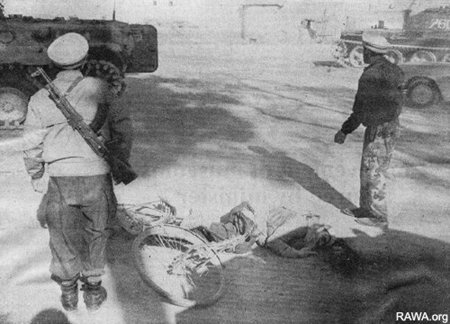Una Moore
Representatives from Hezb-i-Islami, the smallest of Afghanistan’s three major insurgent groups, met with the Afghan president and the United Nations Assistance Mission this week to discuss a list of 15 conditions demanded in exchange for the group laying down its arms. Part 1 of a 2 part series about why these developments should be treated with extreme caution.

January 17, 1994: The body of a bicyclist in Kabul who was killed by a long-range rocket fired by Hezb-e-Islami of Hekmatyar.
(Kabul:) The insurgent group Hezb-i-Islami (there’s an affiliated political party of the same name) is led by Gulbuddin Hekmatyar, arguably the most brutal Afghan warlord of the past 30 years.
During the first half of Afghanistan’s civil war in the 1990’s, Hekmatyar’s forces committed atrocities that elsewhere in the world are met with international arrest warrants and indictments for war crimes and crimes against humanity –not hints of future inclusion in government.
Hekmatyar’s fighters killed tens of thousands by deliberately shelling Kabul. They kidnapped, tortured, raped and killed countless civilians in ways so gruesome that many Afghans, especially Kabul residents, flinch at the mention of Hekmatyar’s name to this day. (An Afghan refugee once described to me Hezb-i-Islami fighters entertaining themselves by pouring hot oil on a freshly decapitated body to make it flail involuntarily.) When Hekmatyar was done with Afghanistan’s capital city, it looked like Hiroshima, and it will still be recovering decades from now.
In 1994, New York Times reporter Tim Weiner met Hekmatyar and described the attitude with which the militia commander approached butchering civilians:
Talking with Hekmatyar is like listening to wind chimes tinkling on the porch of a burning building. A disarmingly feline man, he purses his lips and talks dispassionately of the death of millions. His aim is to build "a true Islamic republic," under his dominion, and he has the will and the weapons to fulfill that dream. If it takes another generation of war, so be it.
By then, Hekmatyar had presided over the killing of at least 10,000 people (for comparison purposes, that’s roughly the number of people killed in the Kosovo war). Hekmatyar’s body count is higher now, and still climbing. He’s never been indicted, and he probably never will be, but in the eyes of ordinary Afghans, he’s a war criminal unfit to live amongst his victims, let alone govern them.
It’s still unclear how exactly Hekmatyar would be brought into the Afghan government, but granting him any position of influence –and he wouldn’t likely settle for a symbolic post—would have a chilling effect on Afghanistan’s beleaguered democrats. Offering his deputies additional positions would be worse still. Hezb-i-Islami’s political wing is the most conservative in the Afghan government already, and while officially opposed to violence, it is also manifestly anti-democratic.
Among the demands made by the insurgent Hezb-i-Islami delegates in Kabul this week are presidential, parliamentary and provincial council elections in 2011 and the formation of a coalition government. If even some of these are acquiesced to, in violation of the constitution, Hezb-i-Islami could seize a greater share of power than it has now, by intimidating political challengers and voters, and rigging polls. If this happens, Afghanistan can expect the already low number of democrats and women in elected office to further dwindle.



